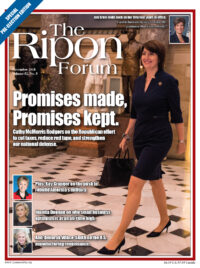
The American manufacturing sector matters, for its pivotal role in driving U.S. economic growth, value added and job creation across the economy, for its critical role in innovation and as the largest funder of U.S. R&D, and for its indispensable role in U.S. national security.
U.S. manufacturing stands at a crossroads. A deep transition in the world order of production during the 2000s leveled a severe blow. From 2001-2013, we lost about 62,800 manufacturing establishments and, from 2001-2010, we lost about 5 million manufacturing jobs.
Now U.S. manufacturing is rebounding. We’ve gained back 15,000 manufacturing establishments and more than a million manufacturing jobs, with 278,000 of those jobs coming in the past year alone. Private fixed investment in industrial equipment is surging, up $100 billion to more than $240 billion annually compared to 2010, while real gross private investment in R&D is up more than $115 billion annually since 2010, reaching more than $408 billion a year.
We’ve gained back 15,000 manufacturing establishments and more than a million manufacturing jobs, with 278,000 of those jobs coming in the past year alone.
Manufacturers are optimistic after a long-needed cut in the corporate tax rate to a globally competitive level, and with the promise of reduced regulatory burdens, new trade agreements in the works, and a crackdown to protect American intellectual property. Energy and manufacturing are inextricably linked and, thanks to new technology, U.S. energy is more abundant than ever. As the world’s top producer of natural gas and petroleum, the United States is producing at record levels. With energy a major cost factor in production, lower cost supplies mean greater global competitiveness for many U.S. producers.
At the same time, U.S. manufacturers are transforming their operations in the midst of an ever-evolving digital disruption, using sensors, networks, computing, and big data to optimize their operations and supply chains. The autonomous systems coming to factories will detect and react to problems, and adapt machinery and systems to changing conditions. New revolutionary technologies – from nanotechnology and biomanufacturing, to 3-D printing and artificial intelligence – will offer a host of new opportunities for product innovations.
But this is no time to take a breather with competitive challengers breathing down our neck, particularly a rapidly strengthening China that has taken aim at world leadership in technology and the geopolitical power that confers. China’s investment in R&D has more than doubled since 2010, reaching $451 billion in 2016 – which is second only to U.S. investment, and set to outpace the United States by the end of this decade. China has overtaken the United States in science and engineering publications, has posted double-digit growth rates in international patent filings in every year since 2003, and now lags behind only the United States in patents filed. While the United States remains the world leader in high-tech manufacturing, with a 31 percent global share and growing output, China has a 24 percent share and is closing the gap with the United States.
Abundant U.S. energy, and the unprecedented flow of new technologies transforming the U.S. manufacturing sector and raising its potential for innovation, can be America’s springboard for its future competitiveness, productivity, economic growth, and higher wage jobs. But an outdated regulatory and physical infrastructure, lack of a coordinated research agenda, insufficiently-funded R&D, and a skills gap could hold us back.
The bipartisan Council on Competitiveness just released Accelerate: Turbocharging the Manufacturing Renaissance in an Era of Energy Abundance, a policy roadmap of concrete actions to take to help unleash America’s strengths, boost our manufacturing engines, and raise technology commercialization to new heights.
This is no time to take a breather with competitive challengers breathing down our neck, particularly a rapidly strengthening China.
High on the policy agenda is creating a modern regulatory infrastructure that keeps pace with innovation and does not create unnecessary burdens on advancing new technologies to the marketplace. We must break the cycle of incremental infrastructure improvements, with major increases in Federal and state investment for repairs and modernization. As we do so, we must also look to the future, to deploying a transformative 21st century infrastructure with intelligent roads and highways, smart grids, automated transit, and smart energy-efficient cities.
Increasing Federal R&D investment will help reaffirm U.S. leadership in knowledge creation, and our national research agenda should be aligned with disruptive technologies with high potential for economic and social impact. To help ensure our research investments return economic gains, we must support and accelerate advanced technology development in the United States from start-up to scale-up. Actions to spur broader deployment of the Internet of Things and cyber secure systems, and greater exploitation of the data tsunami are needed. Finally, we must take steps to ensure our workforce is capable of succeeding in a hyper-connected, hyper-competitive advanced technology-based economy.
We can either seize the opportunity in front of us or watch others take the lead. If we act now, better leveraging and optimizing our competitive assets for this new era of technology disruption and transformation, we can extend our rebound into a bold, productive, and prosperous manufacturing renaissance.
Deborah Wince-Smith is President and CEO of the Council on Competitiveness, a bipartisan leadership organization of corporate CEOs, university presidents, labor leaders, and national laboratory directors dedicated to advancing U.S. competitiveness in the global economy.




